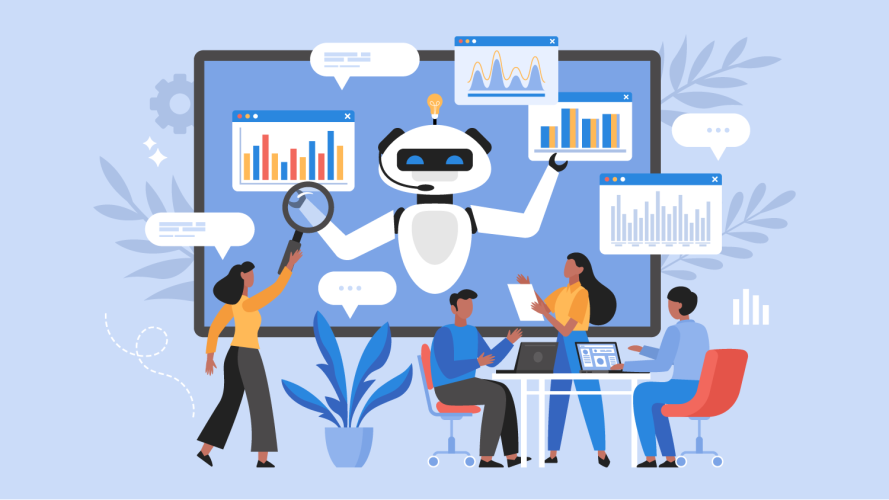So You’ve Automated Everything — What’s Left For Your Employees?



Will work become harder as menial tasks disappear, or will people feel creative and more focused? Here’s what the experts say.

Ivy Wright
Automation has transformed my morning. When I wake up, I push one button to open the shades, turn off the house alarm, and change the lights to a brighter setting. Motion sensors mean I never have to flip a light switch. I have another button that starts a sequence when I leave the house and for when I go to bed. I save about 20 to 30 minutes a day due to home automation.
But what is the impact of automation at work?
You’ve probably heard that automation will eliminate nearly all repetitive, manual, brain-numbing tasks. But is that really what workers want? What happens when all the simple tasks are gone? What happens when we’re just left with more complex work?
Paul Gaffney, chief technology and supply chain officer at Kohl’s, raised this question during a panel discussion at a recent Fortune Brainstorm Tech event. New jobs will be more complicated because the simple tasks will be taken by AI, he said, pointing out that “sometimes people don’t want more complicated jobs.”
This got us thinking about what the future workday will look like after all the simple tasks are automated.
After automation, what comes next?
Let’s start with what can actually be automated. What does the future really look like with automation and artificial intelligence operating at full speed?
“People are not enjoying work right now,” said Muddu Sudhakar, CEO of Aisera, an automation platform that just received $90 million in investor funding. “About 20-30% of work is highly mundane. No human should be doing that. Eliminating mundane tasks will give people a dedicated block of time where they can focus and not lose their train of thought with interruptions.”
Sudhaker’s statement rings true in the midst of the various “great” movements right now, such as The Great Resignation and The Great Disconnect.
“Look at how driverless cars are taking away multitasking,” said Sudhakar. “We’re literally saving lives. AI will be the same as the driverless car for people. It will drive and save mental health.”
In terms of what work will be left, Sudhakar challenges the assumption that people don’t want to do harder work. “As you make work more interesting and challenging, burnout will decrease. People have to know that they are contributing, making a difference, doing a good job.”
Automation for every team
Efficiency, productivity, and cost containment are top priorities for business leaders. MuleSoft helps organizations automate and integrate work across every business function and system, so you can focus on the things that grow your business.



The current impact of automation at work
But, what will these “harder,” more focused work days look like? While we’re at it, just how many hours can humans even be productive in a day?
You’ve probably already heard about the automation and fulfillment robots that Amazon uses to ensure same-day and next-day delivery. They also make people’s jobs easier so that they are not lifting heavy objects and have more time to focus on more rewarding work.
But, what does the impact of automation look like across other industries? Here are some tasks that are likely to go away or change significantly with automation:
- Finance and accounting: For accounts payable, data capture is automated (no more digging through miles of spreadsheets), invoices are automatically matched to relevant documents, and approvals are routed.
- Marketing: There will be no pressing “send” on every email, campaign, or social-media post you create. We will target customers by identifying the audience, designing the most relevant content, and automatically triggering actions like offers based on schedules and customer behavior.
- Customer service: It doesn’t take a human to answer basic questions like “How do I reset my password?” or “Where’s my order?” Next-generation service automation, using AI, augmented reality, and the Internet of Things (IoT), can predict service events and resolve them through digital channels.
- Human resources: Job application processing, response tracking, interview scheduling, job offers, onboarding and offboarding, payroll management, and benefits administration will all be automated.
- Sales: Sales strategy and planning, lead identification and qualification, configuration, pricing and quotation, order management, and post sales are all areas ripe for automation.
How can companies identify opportunities for automation? “One large financial services firm did it by asking employees a simple question: What’s the dumbest thing you have to do every day?” said Matt McLarty, global field chief technology officer and vice president of the digital transformation office at Mulesoft.
Want more examples? Our director of community at Slack, Elizabeth Kinsey, shared what Intuit, IBM, and T-Mobile are automating to free up employees’ time.
After mundane tasks and more are automated, people will have time for deep, focus work. One impact of automation? Imagination and creativity will flourish, and innovation will soar. Things like:
- Competitive research
- Analyzing data
- Developing strategies
- Developing thought leadership
- Fleshing out brainstorm ideas
Do we need a full eight-hour work day?
The idea of the eight-hour workday first became popular in 1866. Think about how many things have changed in the nature of work since then! It started as a means to cap work, but in today’s environment, working over those hours is often tied to appearances of being more productive.
In reality, longer hours have been proven to NOT increase productivity. A study from Stanford University found that after working 50 hours per week, productivity per hour declines sharply. After 55 hours, putting in any more hours would be pointless.
Additionally, The World Health Organization found that working 55 or more hours per week is associated with an estimated 35% higher risk of a stroke and a 17% higher risk of dying from ischemic heart disease, compared to working 35-40 hours a week.
So longer hours can literally kill you, and don’t translate to any more productivity. What’s the right amount of hours then?
“Research indicates that five hours is about the maximum that most of us can concentrate hard on something,” says Alex Pang, founder of Silicon Valley consultancy Strategy and Rest.
There is plenty of evidence to support a five-hour workday. However, sometimes a shorter work day means that everyone is concentrating more work into fewer hours, which can cause stress and actually reverse wellbeing gains.
Another concern is that a shortened work day will only widen the gap between blue-collar and white-collar jobs.
There’s also the increasingly popular four-day work week. The UK just launched the largest trial of the four-day work week, with 73 companies participating in the experiment.
Ireland even has a “Right to Disconnect” code of conduct, which recognizes:
- the right of employees to not to work outside normal business hours
- the right to not be penalized for not working outside those hours
- the duty of employees to respect their coworkers’ right to disconnect
Would one of these models work for you? They might all become more common in the future as companies factor in the impact of automation.
What kind of work will fill those hours — however many there are?
“A farmer still works seven days a week, but the invention of the tractor made their work better,” said Sudhakar. “They could then spend more time looking at better seeds, etc. The same thing will happen in IT and tech. There was the Industrial Revolution, and now there is the IT Revolution. We will be doing the work of tractors.”
Technological innovation makes people better at their jobs. Just look at the invention of autopilot for pilots. Autopilot helps reduce pilot fatigue and decreases operation errors, especially on long flights. Or how the ATM enabled banking customers to seek self service, freeing up bank tellers to focus on more complex customer cases.
There will be many, many new types of work that emerge rapidly over the next few years. The impact of automation will be far and wide.
Hila Lifshitz-Assaf, a professor of management at Warwick Business School and a visiting faculty at Harvard University’s Lab for Innovation Science, gives an assignment to graduate students to look at just this. Her students include managers and company leaders.
She asks students to show how they will work and what their organizations will look like in 10 and 20 years. What will their lifestyles and days look like? Will working for one company still be the norm?
“The assignment is meant to start the imagination of the managers,” said Lifshitz-Assaf. “I have seen a strong desire for flexibility in both things like location and time zone and the type of life they want to live, including family and hobbies.”
Lifshitz-Assaf, a scholar at the Academy of Management, has also observed a need for belonging and community. But, it doesn’t have to come from their workplace and co-workers. For example, “there is a group of people in Paris that work online for different companies, and these professionals choose to work together in a space,” said Lifshitz-Assaf. “Not because they are co-workers, because they have similar jobs and enjoy each other’s company.”
What should leaders do now to prepare for the impact of automation?
When asked for her advice on what leaders should be focusing on now, Lifshitz-Assaf points to getting organized. “Now is the time to look for new ways to get organized. If we don’t find them, we should experiment. There’s no right or wrong right now. Ask employees what they would like to experiment with and see how it works. This will also engage employees and improve retention.”
New configurations of working that don’t require technology can be short three- to four-month experiments. Configurations should incorporate a meaningful and healthy work life. Play with these and nuance them. Let employees co-lead. Grant permission to try new things and new ways. Above all, make it engaging, enticing, interesting, and different.
Unlike organizational experiments, when experimenting in automation and AI, longer investments are key. “The biggest leadership pitfall right now is not making enough and long enough big bets on AI,” said Sudhakar. “Leaders need to make a bet and stick with it for two to four years. Apple spent six years on their big bet with Citi. And it was the same with Alexa and Google Home.”
Beyond investing in technology, Sudhakar pointed to investments in training people. “With AI, don’t look at what you’re losing, retrain yourself. People will become experts in AI, and there will be brand-new jobs for these experts. If you teach people more AI, automation, and programming, you’re lining up their career.”
And that need to invest in tech skills for your employees is urgent. According to Salesforce’s 2022 Digital Skills Readiness Index, across 19 surveyed countries, workers scored 33 out of a possible 100 points on the Digital Skills Readiness Index across areas such as preparedness, access to learning resources, skill level, and participation in training.
There is no one solution here. It will take both small and monumental shifts to succeed in the future of work. Start with giving employees autonomy. Let them get their tasks done in whatever time frame they need. Parents can pick their kids up from school. Caregivers can take time off during the day for appointments. Let night owls burn the midnight oil. However, make sure you are rewarding staff based on productivity and not who is putting in more hours.
A recent study found that a quarter of non-executive employees say they feel stressed all or most of the time. And this rises to 49% for supervisors. Watch your team for signs of burnout and stress. Conduct regular surveys with anonymous, continual feedback to know what is working. Thrive Global outlines these eight factors to predict burnout. McLean Hospital, a Harvard Medical School affiliate, offers these tips on how to manage stress in the workplace.
Overall, place your faith in employees and experimentation to find your future of work.























